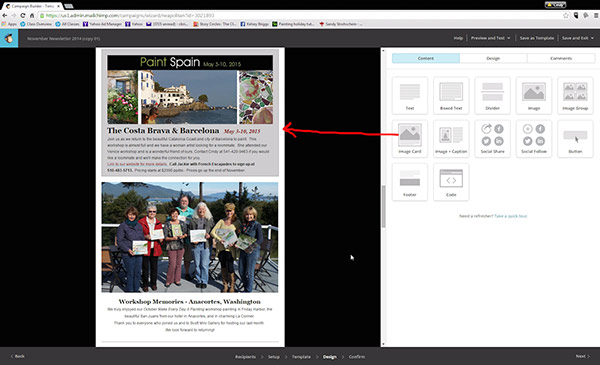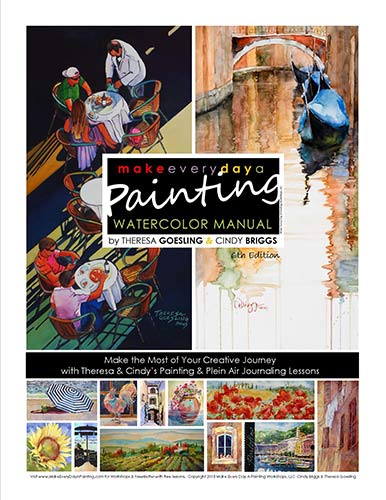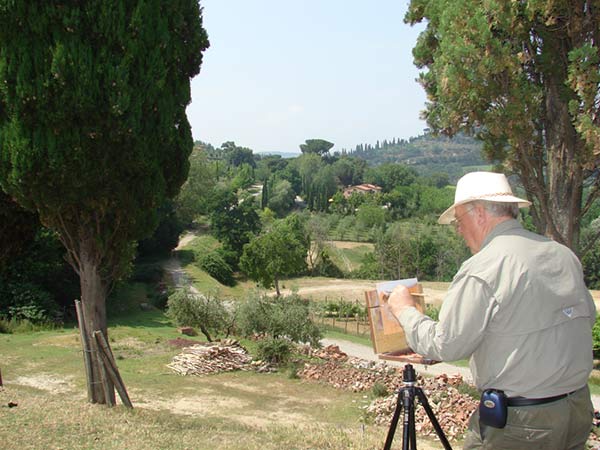This is the second in a three-part series in which Cindy Briggs and Theresa Goesling share their expertise on running painting workshops overseas, or at least outside of one’s studio. In this first installment, we explored the planning and preparation of a workshop. Part II, below, will look at marketing. Part III will examine the execution of a successful workshop.
Lead Image: Goesling and Briggs advise workshop organizers to take a photo of each workshop participant, both for marketing purposes and for customer service — to remind them of what they did.
Briggs has two essential bits of advice: target your marketing efficiently, and market to this group aggressively. “Know your target market,” she says succinctly. “Don’t advertise to those who can’t afford it or won’t want to go. It’s a very select group of people who can afford it and who want to do a painting workshop in your specific medium. Don’t advertise to pastelists if you’re teaching watercolor or oil. The students who will go with you are people who you know or who have already taken workshops with you or get your newsletter.” Briggs advertises on websites and in regional magazines, but she advises being precise in your expenditures. “Many spend more on advertising than they need.”

An early question to ask is, what is my message? Some people refer to this as the “unique selling proposition.” It basically explains why your product — in this case, your plein air workshop — is different from the others. Everyone has one, but some don’t do a good job in presenting it to their target market. Figure out your unique selling proposition, and make sure your marketing material talks about it.
Briggs and Goesling then advise people to simplify their message, while still being as thorough as necessary. The unique selling proposition has to be front and center, but if enough key information is missing from the message, potential attendees might not act on it.

The next step is to get your message to potential participants. Goesling and Briggs’s company, Make Every Day a Painting Workshops, relies heavily on social media and on its e-mailed newsletter. “We get at least half of our signups through the newsletter,” says Briggs. “Many have done something with us before. Often we offer a discount to them, and we offer an opportunity to sign up before the general public can. It is key for us. We use MailChimp, and that company makes it very easy. Once you set up the first e-newsletter, you can replicate it easily and just put in new pictures and text.”
Many artists will immediately respond, “But I want to spend my time painting, not writing newsletters.” Briggs agrees, but she bites the bullet when the time comes. “It’s impossible for us to make a newsletter once a week,” she says. “We don’t even make one once a month. In part, this is so the people on the e-mail list don’t get something too often.”

One of the ways Briggs and Goesling ensure that their e-mailed newsletter gets opened and read is by often including a free lesson or resource, usually in PDF form, that the recipient can download. “They are getting something for free, which they like,” says Briggs. “We put the free lessons at the end of the newsletter. We also include photographs — especially group photos — from past trips. People like that.”

Of course, you have to have people to send the newsletter to. “It helps if you build a following,” Briggs says in an understatement. “A newsletter list must be carefully put together. We gather e-mails at workshops, during demos, any chance we can. If you put them into an Excel spreadsheet, the addresses are very easy to upload to MailChimp and keep track of there. You can see who opened the newsletter and what they clicked on. It’s free until you have so many thousands on your list, then you have to start paying something. If you have 500 people on your list — even just 300 people if they are past students — that’s a strong list. Our list is in the thousands, and we get very few unsubscribes. Most artists who want to do this sort of thing already have a couple hundred names.” Additional e-mail addresses can be obtained by offering the newsletter via Facebook, Instagram, and similar social media outlets.
The last thing a plein air workshop organizer must do to make the marketing effort a success is make signing up for the workshop as easy as possible. “Put a button on your website; make it easy for them,” says Briggs.

The next and final installment in this series will focus on the execution of a workshop.




